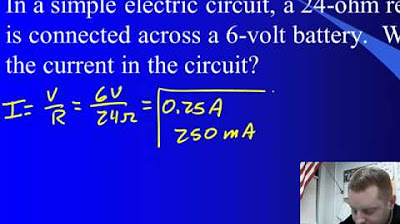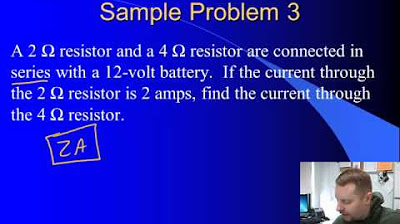Intro to Ohm's Law & Deeper Look at Voltage in Circuits
TLDRIn this educational video, the presenter delves into the fundamentals of Ohm's Law and the concept of voltage in electric circuits. By exploring various battery types and sizes, the video demonstrates how Ohm's Law can be applied to calculate current and explains the difference between theory and practical application. The discussion extends to the distinction between AC and DC current, highlighting the importance of understanding voltage, current, and resistance for anyone working with circuits.
Takeaways
- 📚 Ohm's Law is a fundamental principle in electric circuits, stating that the voltage across any passive circuit element is equal to the current passing through it multiplied by its resistance (V=IR).
- 🔋 Batteries of different sizes (e.g., D cells, C cells, AAA) typically have similar voltages but vary in their ability to supply current, which is related to their physical size and the surface area available for chemical reactions.
- 🔌 The current-voltage relationship in a circuit is linear when dealing with linear components like resistors, meaning that as voltage increases, current increases proportionally.
- 🔄 The voltage of a battery can drop when it is unable to supply the current demanded by the circuit, which can be observed when connecting batteries to different resistances.
- 🔩 In reality, factors such as internal resistance and the efficiency of chemical reactions within the battery can cause deviations from the theoretical predictions of Ohm's Law.
- 🧪 Experiments with various resistors and batteries demonstrate that smaller batteries struggle to supply high currents as predicted by Ohm's Law, while larger batteries can supply more current for longer periods.
- 🔌 The concept of internal resistance in batteries affects their ability to supply current; smaller batteries have higher internal resistance, limiting their current output.
- 💡 Voltage is often thought of as the 'push' in an electric circuit, driving electrons from one terminal to another, and can be visualized as the potential energy at the top of a mountain.
- 🔄 Alternating Current (AC) and Direct Current (DC) are two types of current; AC changes direction periodically (as in power supplied from the wall outlets), while DC flows in one constant direction (as from batteries).
- 🌐 The difference between theory and practice in circuit analysis is highlighted by the fact that theoretical calculations based on Ohm's Law may not perfectly match real-world measurements due to various factors, including component tolerances and measurement inaccuracies.
Q & A
What is Ohm's Law and how is it applied in electric circuits?
-Ohm's Law is a fundamental principle in electrical engineering that states the relationship between voltage (V), current (I), and resistance (R) in a circuit. It is given by the formula V = IR, where V is the voltage across a component, I is the current flowing through it, and R is its resistance. This law helps calculate the current in a circuit when the voltage and resistance are known, and is used to design and analyze various electrical and electronic systems.
What does voltage represent in an electric circuit?
-Voltage represents the electric potential difference or 'push' in an electric circuit. It is the force that drives the flow of electrons, analogous to the pressure in a water pipe. Voltage is typically provided by a power source like a battery or a power supply unit and is measured in volts (V). The higher the voltage, the greater the potential for current to flow in the circuit.
What is the role of resistance in Ohm's Law?
-Resistance (R) in Ohm's Law is a measure of how much a material opposes the flow of electric current. It is directly proportional to the current (I) and the voltage (V) across it, as described by the formula V = IR. A higher resistance will result in a lower current for a given voltage, indicating that the material is a better resistor of electric current.
Why do we have different sizes of batteries with similar voltages?
-Different sizes of batteries with similar voltages exist because, despite the same voltage, their ability to supply current can vary significantly. Larger batteries have a greater surface area for chemical reactions, allowing them to supply more current for longer periods. Smaller batteries, on the other hand, have less surface area and thus cannot supply as much current, making them suitable for low-current devices like remote controls or small electronics.
What is the difference between DC and AC current?
-DC (Direct Current) is the unidirectional flow of electric charge (electrons) in a circuit, where the current flows in one constant direction. AC (Alternating Current), on the other hand, involves a periodic change in the direction of the current flow, typically in the form of a sine wave. AC is the standard for power transmission and distribution in most countries due to its efficiency over long distances, while DC is commonly used in batteries and electronic devices.
How does the internal resistance of a battery affect its performance?
-The internal resistance of a battery affects its ability to supply the required current as demanded by the connected load. A battery with high internal resistance will struggle to deliver high current, leading to a drop in terminal voltage when a load is applied. This can result in the battery not being able to meet the theoretical current values calculated by Ohm's Law, especially for high-current applications.
What happens when a battery is unable to supply the current demanded by Ohm's Law?
-When a battery cannot supply the current demanded by Ohm's Law, the terminal voltage of the battery drops below its open-circuit voltage. This drop occurs because the internal chemical reactions cannot keep up with the demand, leading to a reduction in the potential difference across the battery terminals. This results in the actual current supplied being less than the theoretical value predicted by Ohm's Law.
How does the size of a battery affect its ability to supply current?
-The size of a battery directly affects its internal surface area available for the chemical reactions that generate the electric current. Larger batteries have more surface area, which allows them to produce and supply more current. Smaller batteries, with less surface area, are limited in the amount of current they can supply, which can lead to a lower actual current output compared to the theoretical values given by Ohm's Law.
What is the significance of the voltage drop observed in a battery when it is unable to supply the required current?
-The voltage drop in a battery when it cannot supply the required current is an indication of the battery's inability to maintain its rated voltage under load. This drop is due to the internal resistance of the battery and the limitations of the chemical reactions taking place inside. It signifies that the battery is struggling to meet the demands of the circuit and may not be suitable for high-current applications.
How does the concept of Ohm's Law relate to the design and analysis of electrical circuits?
-Ohm's Law is crucial in the design and analysis of electrical circuits as it provides a fundamental relationship between voltage, current, and resistance. Engineers and technicians use this law to calculate the expected current in a circuit, design circuits to handle specific power requirements, and troubleshoot issues related to power flow and resistance. It is a cornerstone principle that underpins the functionality and performance of electrical and electronic systems.
Outlines
📚 Introduction to Ohm's Law and Voltage
This paragraph introduces the concept of Ohm's Law and voltage in electric circuits. It explains that Ohm's Law is a fundamental principle used to calculate the current in a circuit and that voltage is the push in an electric circuit. The speaker uses the analogy of a battery as a mountain to explain how voltage works, with electrons flowing downhill due to the electric field. The paragraph sets the stage for a deeper exploration of these concepts and their practical applications in building and understanding circuits.
🔋 Understanding Battery Voltages and Sizes
The speaker discusses the various sizes and voltages of batteries, noting that despite similar voltage ratings, different sizes of batteries are used based on the required current output. The explanation includes a comparison of large and small batteries, highlighting that larger batteries can typically provide more current due to their size and internal construction. The paragraph emphasizes the importance of understanding the relationship between battery size, voltage, and current capacity for practical circuit design.
🧪 Experimenting with Ohm's Law and Battery Current
In this section, the speaker conducts an experiment to demonstrate Ohm's Law in practice. By connecting different resistors to both a large and small battery, the speaker measures the resulting current to show how the physical size of the battery affects its ability to supply the required current as per Ohm's Law. The experiment reveals that while the theoretical current can be calculated, the actual current provided by the battery is limited by its physical capacity and internal resistance.
🔌 Exploring the Limitations of Batteries in Circuits
The speaker continues the discussion on the limitations of batteries in supplying current as demanded by Ohm's Law. It is highlighted that smaller batteries struggle to supply higher current due to their limited surface area for chemical reactions. The speaker uses the analogy of a large versus small mountain to explain the difference in current supply capabilities. The paragraph also touches on the concept of internal battery resistance and how it affects the ability of a battery to supply the required current for a circuit.
🔄 AC vs DC Current and Battery Understanding
The speaker concludes the lesson by discussing the difference between AC (alternating current) and DC (direct current). It explains that while the batteries used in the experiment and the power supply are DC, providing a constant flow of current in one direction, AC current changes direction periodically. The speaker also mentions that AC is used for power transmission due to its efficiency and that the electricity in homes is AC, while portable devices run on DC power. The paragraph wraps up the topic of voltage and Ohm's Law, encouraging further exploration into current and resistance in future lessons.
Mindmap
Keywords
💡Ohm's Law
💡Voltage
💡Current
💡Resistance
💡Direct Current (DC)
💡Alternating Current (AC)
💡Battery Chemistry
💡Electric Circuit
💡Linear Relationship
💡Theory vs. Reality
Highlights
Introduction to Ohm's law and its fundamental role in understanding electric circuits.
Exploration of the concept of voltage in electric circuits and its analogy to the push in a circuit.
Discussion on the variety of battery sizes and voltages, and the reason behind their similarities.
Practical demonstration of Ohm's law using different resistors and a six-volt battery.
Verification of theoretical calculations of current against real-world measurements.
Explanation of the linear relationship between voltage, current, and resistance as described by Ohm's law.
Experiment showing the difference in current supply between large and small batteries when connected to various resistors.
Observation that smaller batteries cannot supply as much current as larger batteries, even at the same voltage.
Discussion on the internal resistance of batteries and how it affects their ability to supply current.
Explanation of how voltage drops when a battery is unable to supply the required current.
Introduction to the difference between AC (alternating current) and DC (direct current).
Explanation of why AC is used for power transmission and is more efficient over long distances.
Overview of the frequency of AC current and how it relates to the generation of electricity.
Conclusion on the importance of Ohm's law in predicting the theoretical performance of electric circuits.
Preview of upcoming lessons focusing on a deeper understanding of current and resistance.
Transcripts
5.0 / 5 (0 votes)
Thanks for rating:





